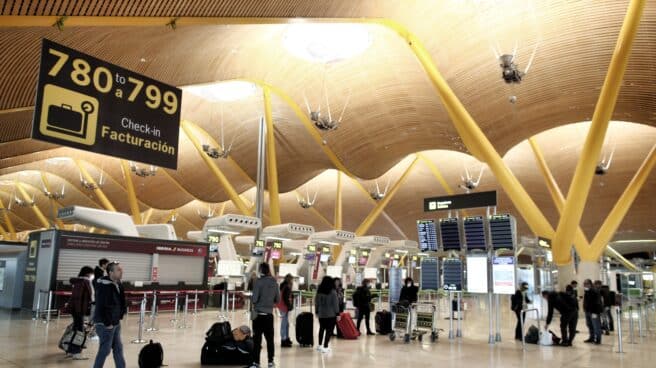

A line of passengers waits at Terminal 4 of Madrid-Barajas Adolfo Suarez Airport.
Airports Madrid-Barajas And Barcelona-El Prat Traveler numbers nearly reached pre-pandemic levels in October. Both airfields are less than 2% below pre-health crisis records, while the airport as a whole is 7.8% above, an all-time high.
Data from the airport manager, released this Monday, shows that both facilities have not yet completed construction compared to the stage preceding corona virus. Of course, in terms of air travel, Barajas is still 7.4% below 2019 levels, and El Prat is 5.6%.
Data for the year as a whole shows the difference between the first and second highest passenger volumes in 2019. The situation is worse at Barcelona Airport, which is still 6.9% below the pre-Covid stage, while Barcelona Airport Madrid barely needs to recover 3.3% of travelers. The number of transactions is still 9.1% and 9.6% below this period.
When it comes to air cargo, Madrid-Barajas is far superior to Barcelona airfield. Specifically, on a year-over-year basis, the former is 14.1% above pre-health crisis records, while the latter remains 11.4% below. The fall was especially noticeable at the airport. Zaragoza, where Inditex has a Zara logistics center. There, cargo transportation figures are 28% lower than then, although 12.6% more than last year.
In October, Palma de Mallorca is 12.4% above pre-pandemic levels; Malaga – Costa del Sol – 18.3%; Alicante, 11.1%; Gran Canaria – 12.5%; Tenerife South, 14.7%; Valencia – 25.9%; and Ibiza – 20.5%. The growth rate for the year as a whole is less significant. And among the main ones, the greatest growth is observed in Valencia (16.5%) and Malaga (10.6%).
The airport manager recorded a historic passenger count of 26.6 million for the fourth month in a row. Traffic from Asia still needs to recover, and the country’s two main airports are also seeing a decline in business travelers. Between January and October, 243.2 million passengers passed through Spanish airports managed by Aena; 16.9% more than last year and 1.9% more than 2019.
According to information conveyed a few days ago by the airport manager, chaired by Maurici Lucena, the company, owned by the public enterprise Enaire, estimates that the 2023 financial year will end with approximately 280 million passengers in Spain, which would be equivalent to a recovery of 102% of 2019 traffic, within the expected range for 2023 (94%-104% of 2019 traffic).
Ahead of the winter season, which began on October 29, the company also said that airlines had planned 126.6 million seats and almost 731,000 commercial operations at airports in the Aena network. Thus, until the next March 30, there will be 15.1% more places than there were in the same season 2022-2023.
In terms of airports, the largest number of slots on offer are Madrid-Barajas Adolfo Suárez Airport with over 31.4 million slots and Josep Tarradellas Barcelona-El Prat Airport with 23.8 million slots. Both exceed the 2022 winter season figures by 12% and 20%, respectively. The sitting and movement program can always be changed by the manufacturer. airlines.
Until September Ryanair It is the undisputed leader in Spanish airports with 47.1 million users in the first nine months of the year. The Irish low-cost carrier received 21% more passengers through September than in the same period of the year before the pandemic, and is ahead of its main rival in Spain, the Catalan Vuelingfrom the IAG group. The latter carried 35.4 million passengers until September.
Iberia, for its part, carried 16 million passengers, while its subsidiary Iberia Express carried 9.2 million. Together they hold 11.6% of the market, with Ryanair controlling 21.8% and Vueling 16.4%.
Other airlines are carrying even fewer passengers than before the health crisis. Air Europe (-12.7%), Easyjet (-14.3%) and Air Nostrum (-10.5%) are three of those that are among the major companies operating in our country, although all of them are recovering compared to 2022 figures.
Source: El Independiente